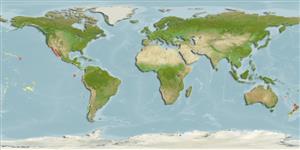>
Blenniiformes (Blennies) >
Blenniidae (Combtooth blennies) > Salariinae
Etymology: Hypsoblennius: Greek, hypsi = high + Greek, blennios = mucus (Ref. 45335).
More on author: Girard.
Environment: milieu / climate zone / depth range / distribution range
Ecologie
marien; brak water demersaal; diepte 0 - 25 m (Ref. 37955), usually ? - 10 m (Ref. 56052). Subtropical; 37°N -
Eastern Central Pacific: Monterey Bay, California, USA to Bahia Magdalena (Baja California Sur, Mexico) and the Gulf of California.
Grootte / Gewicht / Leeftijd
Maturity: Lm ? range ? - ? cm
Max length : 15.0 cm TL mannelijk / geslacht onbekend; (Ref. 2850); max. gerapporteerde leeftijd: 7 Jaren (Ref. 56052)
Adults are found in intertidal shallows (Ref. 11482). Territorial (Ref. 37955). They feed on small benthic invertebrates and algae (Ref. 37955). Demersal spawners in nearshore habitats (Ref. 56049). Oviparous (Ref. 205). Eggs are demersal and adhesive (Ref. 205), and are attached to the walls of the parent's shelter. Eggs are brooded by the male parent (Ref. 56053).
Oviparous, distinct pairing (Ref. 205). Female deposits the eggs in protected areas. The male guards the eggs until hatching (Ref. 37955).
Eschmeyer, W.N., E.S. Herald and H. Hammann, 1983. A field guide to Pacific coast fishes of North America. Boston (MA, USA): Houghton Mifflin Company. xii+336 p. (Ref. 2850)
Status op de Rode Lijst van het IUCN (Ref. 130435)
Gevaar voor de mens
Harmless
Gebruik door de mens
Visserij: commercieel; Aquarium: Commercieel
Tools
Speciale rapporten
Download XML
Internetbronnen
Estimates based on models
Preferred temperature (Ref.
123201): 16.2 - 25.9, mean 21 °C (based on 201 cells).
Fylogenetische diversiteitsindex (Ref.
82804): PD
50 = 0.5000 [Uniqueness, from 0.5 = low to 2.0 = high].
Bayesian length-weight: a=0.00832 (0.00454 - 0.01523), b=3.02 (2.86 - 3.18), in cm total length, based on LWR estimates for this species & (Sub)family-body (Ref.
93245).
Trofisch niveau (Ref.
69278): 2.7 ±0.24 se; based on food items.
Weerstandsvermogen (Ref.
120179): Gemiddeld, minimale populatieverdubbelingstijd 1,4-4,4 jaar (tmax=6.5).
Fishing Vulnerability (Ref.
59153): Low vulnerability (10 of 100).
